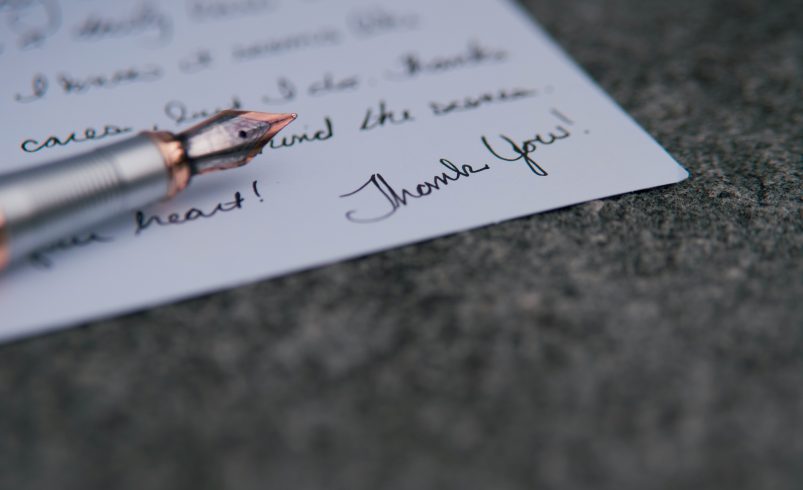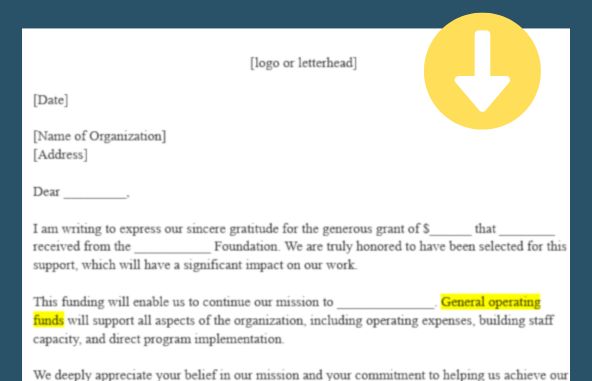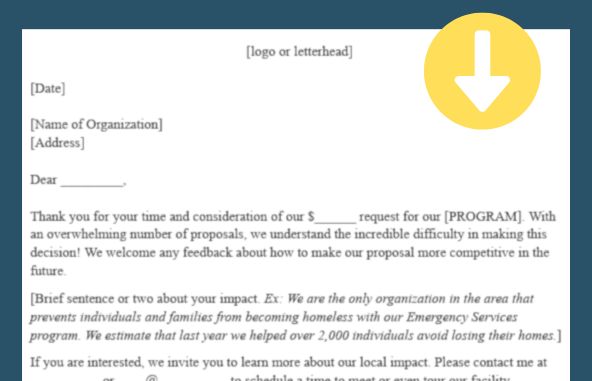
Don’t Forget to Thank Grant Makers (Whether You’re Awarded or Not)
“I’ve learned that people will forget what you said, people will forget what you did, but people will never forget how you made them feel.” – Maya Angelou
Photo by Aaron Burden on Unsplash
Early in my grant writing career, I attended a week-long grant writing workshop complete with a funder roundtable. One of the funders shared that a large percentage of awarded nonprofits never send a thank you letter or acknowledgement of receiving the funds.
Since then, I’ve found that while most nonprofits have a process for thanking individual donors, many forget to extend that process to include thanking grant funders – let alone sending a “thank you for your consideration” letter in response to denials.
Why? Well, we all know time is a scarce commodity at nonprofit organizations. It takes time to coordinate funding acknowledgement and, though having a process in place would save so much time down the line, creating the process itself takes time.
But a bigger reason may be, in the grant world, we can forget that there are real people behind each grantmaking organization too – people who are passionate about their missions and choosing which organizations to support, like yours.
Some requests are quickly filtered out because they are incomplete, ineligible or clearly misaligned (see our blog on common grant mistakes like these). But in many cases, real people spend time evaluating your proposal. A program officer might champion your organization in front of the grant committee, and decision-makers might end up making a very tight choice between your request and another.
Ultimately, it is people who spend time considering your request. And if you are funded, they made the decision that your cause is worth their investment. A natural next step would be to thank them, right? These people want to feel seen, appreciated and remembered, just as an individual donor would.
Thus, we suggest treating your grant makers the same way you treat your individual donors.
With individual donors, the fundraising best practice is to send a thank you letter within 24 hours of receiving a gift. Most nonprofits have a process to ensure this occurs, whether it’s with sticky notes on a whiteboard, an online spreadsheet, a project management platform or automated distribution through a constituent management system.
Create a similar process for thanking grantmakers, whether they award you or not. Even when it’s a denial, thanking grant makers is a great way to cultivate relationships and become actively engaged in the greater network of people and organizations doing philanthropic work in your sector.
L Pro Tip: If you’re keeping your funder acknowledgement process organized in your head, that’s an impressive skill! Instead, be sure to document it in such a way that others on your team can access and understand it. Such documentation is very helpful for the sustainability of any organization.
How do you say thank you for receiving a grant?
The two standard approaches to thanking grant funders are phone calls and thank you letters. Phone calls are always a good touch if you have a contact within the organization and they accept such calls. Thank-you letters can be sent via email or snail mail, signed by your Executive Director.
However, if you’re able to go above and beyond, we encourage you to craft a custom approach that reflects your organization and its values. We were recently inspired by Haley Chapin, Executive Director of Tri-Lakes Cares, and her keynote presentation at Southern Colorado’s 2025 Summit on Philanthropy (through the Association of Fundraising Professionals Southern Colorado Chapter), Connections that Count: Turning Gratitude into Generosity. During her presentation, she shared the following examples:
- Send a hand-written card or letter signed by everyone on your staff.
- Send a thank you note from a client or participant in your programs (with privacy and confidentiality in mind).
- Include meaningful items with your letter, such as a sticker with your logo, photos from your events or a special token or item that reflects your mission.
You can also “activate” your board members to thank donors – signing cards or making phone calls. They can explain their own personal connection and interest in your mission.
And if you thank the funder publicly on your social media, tag them (with their permission).
We’ve created two free templates for thank you letters to funders you can use to launch your acknowledgement process:
What comes after “thank you?”
Demonstrating gratitude shouldn’t stop after you acknowledge the grant. Continue to include your grant funders in happenings at your organization, much in the same way you likely include individual donors. This can include periodic updates or sending annual reports/materials. Learn more in our blog, How Nonprofits Can Cultivate Strong Relationships with Funders.
Share how you’ve gotten creative with thanking funders in the comments!
L Professional writing is a professional grant writing agency located in the Pikes Peak region. When you work with us, we can provide guidance around best practices for managing your grant program and cultivating great funder relationships. For more advice like this, subscribe to our quarterly newsletter. To learn more about how we can help your organization, contact us at info@lprowriting.com for a one-hour fit call/consultation.





